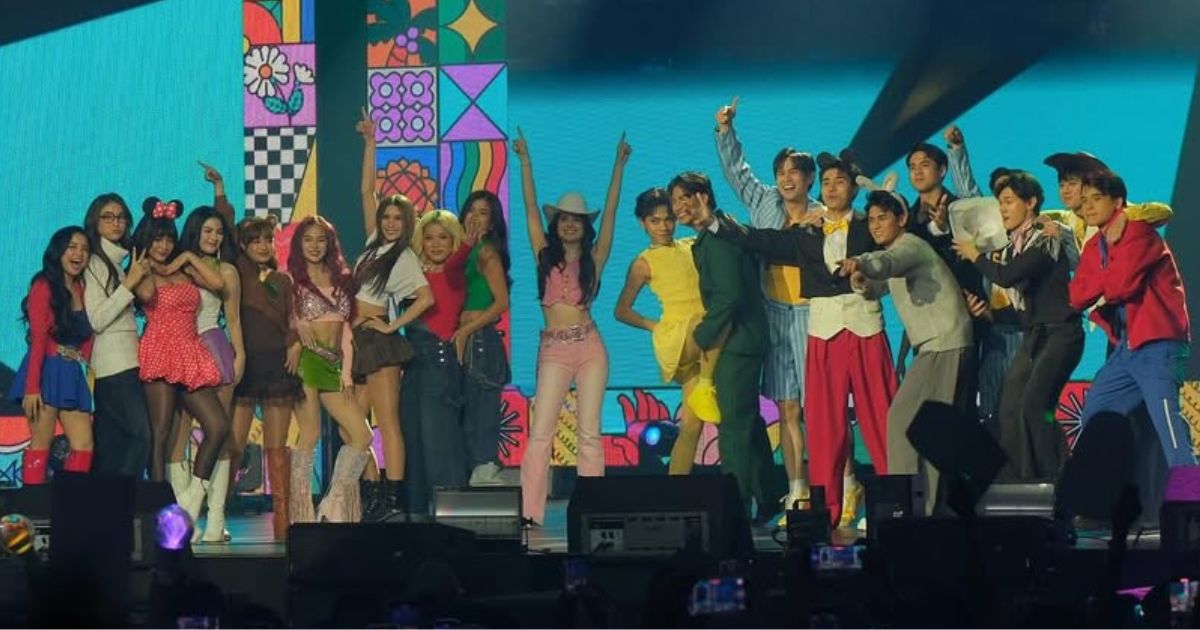The housemates of “Pinoy Big Brother: Celebrity Collab Edition” gave their all to entertain fans at “The Big ColLove” concert held at the Smart Araneta Coliseum.
The concert featured dynamic performances from Kapuso and Kapamilya housemates, filled with fun and heart-fluttering moments that thrilled the audience. Surprise appearances from beloved house guests added to the excitement.
For those who missed the show or want to relive the highlights, here are 10 standout moments from the event.
1. A surprise performance
The concert kicked off with an unexpected performance of “Kakaibabe,” joined by the rest of the housemates.
In a brief interview, the star shared that if they were a regular housemate, they would choose Shuvee as their final duo, playfully suggesting the name “Shuvana.”
2. AcLie as dancing divas
The dancing duo, AC Bonifacio and Charlie Fleming (AcLie), lit up the stage with their energetic dance collaboration.
AC opened with a high-energy performance of “Waiting for Tonight,” while Charlie delivered an electrifying rendition of “Whenever, Wherever.” The duo then combined forces for a dynamic performance of “After Hours.”
3. A sizzling ballroom dance performance
AZ Martinez and River Joseph (AzVer) set the stage on fire with their passionate ballroom performance of “Anxiety” and “Dame un Grr.”
4. A kilig-filled Q&A and dance performance
During a question-and-answer segment, Ralph and Will answered playful fan questions, sparking cheers from the audience. Later, they wowed the crowd with a sleek dance performance of “All These Ladies.”
Adding to the fun, a surprise appearance from Mrs. Castro created a playful love triangle on stage.
5. An impromptu acting challenge
Former child stars Xyriel Manabat and Will Ashley showcased their acting skills in a spontaneous challenge, with Xyriel playing a devoted older sister and Will as her younger brother.
6. A heartfelt duet
Mika Salamanca and Klarisse De Guzman (MiKla) displayed their vocal prowess with a duet of “Sino Nga Ba Siya.”
7. Kilig-filled duets from popular love teams
AZ and Ralph performed “Tibok,” while Kira Balinger and Josh Ford (KiSh) delivered a captivating rendition of “Aya.” The four later joined forces for a special performance of “‘Pag Ang Puso Ang Nagsabi.”
8. A love triangle performance
Will and Bianca (WillCa) began their set with “Akin Ka Na Lang,” before Dustin Yu (DustBia) made a surprise entrance, adding a twist to the performance. Bianca then sang “Sana Dalawa ang Puso Ko,” portraying the emotional struggle of choosing between two loves.
9. A high-energy cheer dance
Charlie and Esnyr (CharEs) amazed the audience with a thrilling cheer dance routine to “Amakabogera,” complete with lifts and aerial stunts.
10. The return of Dee-stiny’s Child
Klarisse, Esnyr, and Michelle Dee reunited as the iconic trio Dee-stiny’s Child, performing powerful renditions of “Dyosa,” “Ganda-gandahan,” and “Reyna.”
Smart Araneta Coliseum
The **Smart Araneta Coliseum**, located in Quezon City, Philippines, is one of the largest indoor arenas in Asia. Opened in 1960, it was originally known as the **Araneta Coliseum** and became famous for hosting historic events, including the “Thrilla in Manila” boxing match between Muhammad Ali and Joe Frazier in 1975. Today, it remains a premier venue for sports, concerts, and cultural events, modernized with advanced technology while retaining its iconic status.
Kakaibabe
There is limited widely known historical or cultural information available about “Kakaibabe,” as it does not appear to be a well-documented place or cultural site. If you are referring to a specific local landmark, folklore, or lesser-known location, additional context would help provide a more accurate summary. Alternatively, “Kakaibabe” may be a misspelling or a reference to a niche or regional subject.
Could you clarify or provide more details about its location or significance? I’d be happy to help!
Waiting for Tonight
“Waiting for Tonight” is not a known cultural site or historical place, but rather a popular song by Jennifer Lopez released in 1999. The dance-pop track became a global hit, celebrating nightlife and anticipation for a memorable evening. If you meant a specific location or cultural reference, please provide more details.
Whenever, Wherever
“Whenever, Wherever” is likely a reference to the popular 2001 song by Shakira, rather than a specific place or cultural site. The song blends Latin pop and world music influences, reflecting themes of love and destiny. While it doesn’t describe a physical location, its global success highlights the cultural impact of Latin music in the early 2000s.
After Hours
“After Hours” is a cultural term often associated with nightlife, referring to social gatherings, clubs, or events that take place late at night or early in the morning, typically after regular business hours. Originating in urban nightlife scenes, it became widely popular in the 20th century, particularly with the rise of jazz, disco, and electronic dance music cultures. These spaces often serve as hubs for music, art, and countercultural movements, fostering creativity and community outside mainstream norms.
Anxiety
“Anxiety” is not a physical place or cultural site but rather a psychological and emotional state characterized by fear, worry, and unease. Historically, the concept has been recognized since ancient times, with early descriptions found in Greek and Roman medical texts, though modern understanding has evolved through psychology and neuroscience. Today, anxiety is studied as both a natural human response and a mental health condition, with cultural and societal factors influencing its expression and treatment.
Dame un Grr
“Dame un Grr” is a playful and humorous phrase often associated with internet culture, particularly in Spanish-speaking communities. It doesn’t refer to a specific physical place or cultural site but is instead a meme or slang expression, sometimes used to mimic a growling sound or express exaggerated affection. Its origins are unclear, but it gained popularity through social media and viral trends.
All These Ladies
“All These Ladies” (Toutes ces Femmes) is a cultural site or artistic expression that celebrates the contributions and stories of women, often through visual art, performances, or installations. While specific historical details may vary depending on the context, such initiatives typically aim to highlight female voices, achievements, and struggles throughout history. They serve as a tribute to gender equality and empowerment, reflecting broader social movements.
(Note: If you’re referring to a specific place or artwork named “All These Ladies,” please provide more details for a more accurate summary!)






